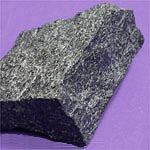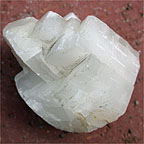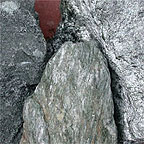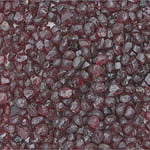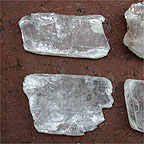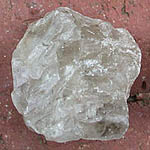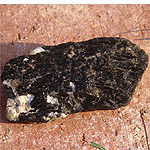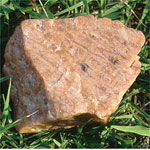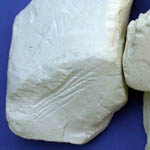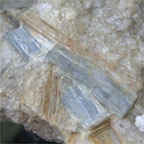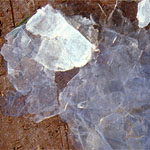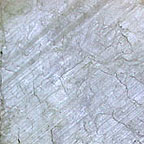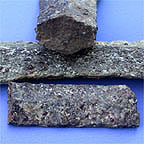|
Mineral
|
Photo
|
Physical Properties
|
|
|
|
Black to dark green; H = 5 to 6; D = 3.2 to 3.4; vitreous to dull luster; two imperfect cleavages meet at nearly 90°; a pyroxene mineral. Another pyroxene, diopside, is similar but is light grayish green.
|
|
|
|
Brown to brownish black; vitreous luster; H = 2.5 to 3.0; D = 2.8 to 3.2; may give a brown-gray streak; individual crystals are commonly small and cleavage surfaces are wavy; one perfect cleavage; transparent, flexible and elastic in thin sheets.
|
|
|
|
Clear, white, other colors less common; vitreous luster; H = 3; D = 2.7; three perfect cleavages form rhombohedric cleavage fragments; double image seen through clear pieces; reacts strongly with dilute hydrochloric acid.
|
|
|
|
Green to blackish green; dull to vitreous or pearly luster; H = 2 to 2.5; D = 2.6 to 3.3; may have faint green-yellow streak; cleavage flakes are flexible but not elastic; finely crystalline aggregates common.
|
|
|
|
Buff, gray, white, pinkish; H = 3.5 to 4; D = 2.8 to 2.9; small, rhombohedral crystals or massive; three cleavages not at 90°, may be indistinct; unless powdered, reacts slowly or not at all with dilute hydrochlorite acid.
|
|
|
|
Most commonly reddish brown or yellowish tan; vitreous to resinous luster; H = 6.5 to 7.5; D = 3.6 to 4.3; twelve-sided crystals (diamond-shaped faces) or roughly spherical crystals common. Broken surfaces may resemble cleavage in some large (> 1 cm) samples.
|
|
|
|
Clear, white, light gray; H = 2; D = 2.3; vitreous to pearly luster; may be able to flake off small brittle sheets; one perfect cleavage and two poor cleavages indicate the selenite variety of gypsum; alabaster is massive, satin spar is fibrous.
|
|
|
|
Clear to gray to red; H = 2.5; D = 2.2; three perfect cleavages meet at 90° (cleavage surfaces may be dull and partially dissolved after prolonged exposure); salty taste.
|
|
Hematite
|
|
First variety: steel gray to dull red; H = 6; D = 5.0; red-brown streak; may be micaceous (tiny flakes) or massive.
Second variety: Red to reddish brown, H = 1.5 to 5.5; D = 5.0; dull luster; red-brown streak; earthy or oolitic (made of spherical structures 0.25 to 2 mm in diameter) masses.
|
|
|
|
Black; H = 5 to 6; D = 3.0 to 3.4; vitreous luster; may have faint green-gray streak; two perfect cleavages meet at 124° and 56°, but cleavage faces are commonly stepped rather than smooth; splintery appearance. An amphibole mineral.
|
|
|
|
Salmon-pink, white, gray, green; vitreous luster; H = 6; D = 2.5 to 2.6; two cleavages meet at nearly 90°; no striations.
|
|
|
|
White; H = 1 to 2.5; D = 2.6; dull luster; greasy feel, earth odor, powdery.
|
|
|
|
Light blue to greenish blue to blue-gray; vitreous luster; H = 5 parallel to long direction of crystal, H = 7 across crystal; blade-shaped crystals; one cleavage.
|
|
|
|
Colorless, silvery white, brownish silvery white; vitreous luster; H = 2.0 to 2.5; D = 2.8 to 2.9; one perfect cleavage; transparent, flexible, and elastic in thin sheets.
|
|
|
|
Olive-green to yellow green; vitreous to dull luster; H = 6.5 to 7 but often difficult to test because many samples are granular aggregates.
|
|
|
|
White to dark gray; sometimes buff; vitreous luster; H = 6; D = 2.6 to 2.8; two cleavages meet at nearly 90°; some cleavage faces have very fine, perfectly straight parallel striations, which show up in reflected light.
|
|
|
|
Brass-yellow; H = 6 to 6.5; D = 5.0; greenish black to black streak; massive or as crystals (cubes or pyritohedra).
|
|
|
|
Coarsely crystalline varieties: clear, milky, white, purple, smokey gray; pink; transparent to translucent; vitreous luster; H = 7; D = 2.7; conchoidal fracture; usually massive but six-sided crystals popular in rock shops; Microcrystalline varieties: chert(gray, dull luster), flint (black, dull luster), chalcedony (brown to gray, translucent, waxy luster), agate and onyx (varicolored bands, vitreous luster).
|
|
|
|
Multicolored green, black, gray; H = 3; D = 2.5 to 2.6; dull to greasy luster; slippery to slightly greasy feel; massive to fibrous (asbestos).
|
|
|
|
Red-brown to brownish black; vitreous, resinous, or dull luster; H = 7 to 7.5; D = 3.7; prismatic and X- or cross-shaped crystals.
|

